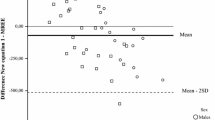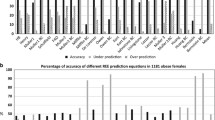Abstract
Resting energy expenditure (REE) was investigated by indirect calorimetry in relation to body composition and to different degrees of obesity in order to assess if a defective energy expenditure contributes to extra body fat accumulation. Differences were found between control subjects (group C; BMI 23±0.5 kg/m2, REE 5890±218 kJ/day; mean±SEM) and obese subjects (group O; BMI 34.2±0.9 kg/m2, REE 7447±360 kJ/day;P<0.0001) and between group C and morbidly obese subjects (group MO; BMI 49.9±1.6 kg/m2, REE 8330±360 kJ/day;P<0.0001); REE was not significantly different between groups O and MO. Body composition data were obtained by means of body impedance analysis. Even though group MO had a fat mass higher than group O, body cell mass, the metabolically active body compartment, was similar in groups O and MO, and this fact may have contributed to the similar REE in the two groups. Multiple regression analysis gave the following equation as the best predictor of REE: REE (kJ/day)+1591±49BW+74BCM−737 G (R 2=0.88), where BW is body weight, BCM is body cell mass andG is a dummy variable coding group membership (group C=1; group O=2; group MO=3). Thus the analysis showed a negative impact of obesity on REE beyond body composition variables.
Similar content being viewed by others
References
James WPT, Bailes K, Davies HL, Dauncey MJ, Elevated metabolic rates in obesity. Lancet I:1122–1125, 1978
Ravussin E, Burnand B, Schutz Y, Jequier E, Twenty-four hour energy expenditure and resting metabolic rate in obese, moderately obese and control subjects. Am J Clin Nutr 35:566–573, 1982
Felig P, Cunningham J, Levitt M, Hendler R, Nadel E, Energy expenditure in obesity in fasting and postprandial state. Am J Physiol 244:E45–E51, 1983
Webster JD, Hesp R, Garrow JS, The composition of excess weight in obese women estimated by body density, total body water and total body potassium. Hum Nutr Clin Nutr 38C:299–306, 1984
Forbes GB, Brown MR, Welle SL, Lipinski BA, Deliberate overfeeding in women and men: energy cost and composition of the weight gain. Br J Nutr 56:1–9, 1986
Cunningham JJ, Body composition as a determinant of energy expenditure: a synthetic review and a proposed general equation. Am J Clin Nutr 54:963–969, 1991
Ravussin E, Lillioja S, Knowler WC, Christin L, Freymond D, Abbott WGH, Boyce V, Howard BV, Bogardus C, Reduced rate of energy expenditure as a risk factor for body-weight gain. N Engl J Med 318:467–472, 1988
Roza AM, Shizgal HM, The Harris Benedict equation reevaluated: resting energy requirements and the body cell mass. Am J Clin Nutr 40:168–182, 1984
National Diabetes Data Group, Classification and diagnosis of diabetes mellitus and other categories of glucose intolerance. Diabetes 28:1039–1057, 1979
Lukaski HC, Johnson PE, Bolonchuk WW, Lykken GI, Assessment of fat-free mass using bioelectrical impedance measurements of the human body. Am J Clin Nutr 41:810–817, 1985
Lukaski HC, Bolonchuk WW, Hall CB, Siders W, Validation of tetrapolar bioelectrical impedance method to assess human body composition. J Appl Physiol 60:1327–1332, 1986
Khaled MA, McCutcheon MJ, Reddy S, Pearman PL, Hunter GR, Weinsier RL, Electrical impedance in assessing human body composition: the BIA-method. Am J Clin Nutr 47:789–792, 1988
Schober O, Lehr L, Hundeshagen H, Bromide space, total body water and sick cell syndrome. Eur J Nucl Med 7:14–15, 1982
Baumgartner RN, Chumlea WC, Roche AF, Bioelectric impedance phase angle and body composition. Am J Clin Nutr 48:16–23, 1988
Jodoin RR, Trott SG, Shizgal HM, Determination of body composition from whole body electrical impedance. Surg Forum 39:50–52, 1988
Fischer H, Lembcke B, Cramer A, Wermer G, Caspary WF, Korrelation impedanzanalytischer Messungen der Körperzellmasse mit der gesamtkörper-40K-Bestimmmung bei Taberzirrhotikern. Z Gastroenterol 28:475–480, 1990
Fischer H, Lembcke B, Die Anwendung der bioelektrischen Impedanzanalyse (BIA) zur Beurteilung der Körperzusammensetzung und des Ernährungszustandes. Innere Medizin 18:13–17, 1991
Ott M, Lembcke B, Fischer H, Jäger R, Polat H, Geier H, Rech M, Staszeswki S, Helm EB, Caspary WF, Early changes of body composition in human immunodeficiency virus-infected patients: tetrapolar body impedance analysis indicates significant malnutrition. Am J Clin Nutr 57:15–19, 1993
Jéquier E, Acheson K, Schutz Y, Assessment of energy expenditure and fuel utilization in man. Ann Rev Nutr 7:187–208, 1987
Owen OE, Kavle E, Owen RS, Polansky M, Caprio S, Mozzoli MA, Kendrick ZV, Bushman MC, Boden G, A reappraisal of caloric requirements in healthy women. Am J Clin Nutr 44:1–19, 1986
Owen OE, Holup JL, D'Alessio DA, Craig ES, Polansky M, Smalley KJ, Kavle EC, Bushman MC, Owen LR, Mozzoli MA, Kendrick ZV, Boden GH, A reappraisal of the caloric requirements of men. Am J Clin Nutr 46:875–885, 1987
Ravussin E, Bogardus C, Relationship of genetics, age, and physical fitness to daily energy expenditure and fuel utilization. Am J Clin Nutr 49:968–975, 1989
Bogardus C, Lillioja S, Ravussin E, Abbott W, Zawadzki JK, Young A, Knowler WC, Jacobowitz R, Moll PP, Familial dependence of the resting metabolic rate. N Engl J Med 315:96–100, 1986
Roberts SB, Savage J, Coward WA, Chew B, Lucas A, Energy expenditure and intake in infants born to lean and overweight mothers. N Engl J Med 318:461–466, 1988
Bouchard C, Tremblay A, Nadeau A, Després JP, Thériault G, Boulay MR, Lortie G, Leblanc C, Fournier G, Genetic effect in resting and exercise metabolic rates. Metabolism 38:364–370, 1989
Mifflin MD, St Jeor ST, Hill LA, Scott BJ, Daugherty SA, Koh YO, A new predictive equation for resting energy expenditure in healthy individuals. Am J Clin Nutr 51:241–247, 1990
Verga S, Buscemi S, Bompiani GD, Glucose-induced thermogenesis in obese subjects with or without familial history of obesity. Eur J Clin Nutr 44:397–404, 1990
Forbes GB, Kreipe RE, Lipinski B, Body composition and the energy cost of weight gain. Hum Nutr Clin Nutr 36C:485–487, 1982
Forbes GB, Lean body mass-body fat interrelationships in humans. Nutr Rev 45:225–231, 1987
Forbes GB, Do obese individuals gain weight more easily than nonobese individual? Am J Clin Nutr 52:224–227, 1990
Alpert SS, Growth, thermogenesis, and hyperphagia. Am J Clin Nutr 52:784–792, 1990
James WPT, McNeill G, Ralph A, Metabolism and nutritional adaptation to altered intakes of energy substrates. Am J Clin Nutr 51:264–269, 1990
Author information
Authors and Affiliations
Rights and permissions
About this article
Cite this article
Verga, S., Buscemi, S. & Caimi, G. Resting energy expenditure and body composition in morbidly obese, obese and control subjects. Acta Diabetol 31, 47–51 (1994). https://doi.org/10.1007/BF00580761
Received:
Accepted:
Issue Date:
DOI: https://doi.org/10.1007/BF00580761




